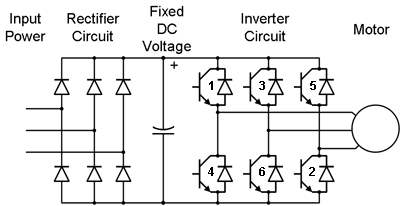Difference between revisions of "HV DC bus"
From Granite Devices Knowledge Wiki
| [checked revision] | [checked revision] |
(Created page with "HV DC bus refers to an internal high voltage DC supply bus of a motor drive. This voltage typically has voltage between 12 to 400 VDC depending on a drive model and is the sou...") |
|||
| Line 1: | Line 1: | ||
| − | HV DC bus refers to an internal high voltage DC supply bus of a motor drive. This voltage typically has voltage between 12 to 400 VDC depending on a drive model and is the source voltage to the power stage that actually drives current to motor windings. | + | [[File:Inverter.gif|thumb|A simplified typical motor drive high voltage circuity with AC input, internal HV DC bus and 3-phase power stage]]HV DC bus refers to an internal high voltage DC supply bus of a motor drive. This voltage typically has voltage between 12 to 400 VDC depending on a drive model and is the source voltage to the power stage that actually drives current to motor windings. |
In [[Argon]] the HV DC bus is generated by rectified AC input voltage, so for example with 230 VAC input the DC but voltage becomes about 325 VDC. | In [[Argon]] the HV DC bus is generated by rectified AC input voltage, so for example with 230 VAC input the DC but voltage becomes about 325 VDC. | ||
[[category:glossary]] | [[category:glossary]] | ||
Revision as of 15:51, 30 October 2013
HV DC bus refers to an internal high voltage DC supply bus of a motor drive. This voltage typically has voltage between 12 to 400 VDC depending on a drive model and is the source voltage to the power stage that actually drives current to motor windings.
In Argon the HV DC bus is generated by rectified AC input voltage, so for example with 230 VAC input the DC but voltage becomes about 325 VDC.
